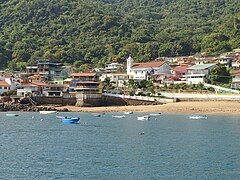geo.wikisort.org - Island
Taboga Island (Spanish: Isla Taboga), also known as the "Island of Flowers", is a volcanic island in the Gulf of Panama. It is a tourist destination, about 20 km from Panama City, Panama.
This article contains content that is written like an advertisement. (November 2022) |
Native name: Isla Taboga Nickname: Island of Flowers | |
|---|---|
 | |
 Taboga Island | |
| Geography | |
| Location | Gulf of Panama |
| Coordinates | 8°47′0″N 79°33′0″W |
| Area | 12.1 km2 (4.7 sq mi) |
| Administration | |
Panama | |
| Province | Panamá |
| District | Taboga |
| Demographics | |
| Population | 1.629 |
| Pop. density | 134.6/km2 (348.6/sq mi) |

History
The island was discovered in the 16th century and was originally named Isla de San Pedro by the Spanish explorer Vasco Núñez de Balboa.[1] Its current name derives from an Indian word aboga ("many fish"). The island's first settlers were Indian slaves from Venezuela and Nicaragua. The small town of San Pedro was founded in 1524 by Hernando de Luque, dean of the Panama cathedral. The town church of the same name is claimed to be the second-oldest church in the hemisphere. Rose of Lima (1586–1617), the first Catholic saint of the Americas, may have been born on the island.[2] French painter Paul Gauguin visited the island in 1887.[3]
Paul Gauguin in Taboga
Having worked for the first (French) attempt to dig a canal from the Caribbean Sea to the Pacific, attempt in which 22000 workers lost their life, French painter Paul Gauguin, taking ill, was sent for treatment in Taboga Island; he then returned to France, with a stopover in Martinique; then left for the Marquesas. His stay in Taboga is marked by an engraved plate on the island's main beach.[4]
Geography
At low tide, the northern end of the island is joined by a sand bar to the small island of El Morro, and the southeastern end is 270 metres (886 feet) from the neighboring Urabá island. The island has a tropical rain forest climate (Af), with average daytime temperatures of 83 °F (28 °C). It is famous for its beautiful beaches, clear waters, soft sands, and wildlife refuge.
Tourism
Tourism is the major economic activity on the island, although fishing and agriculture are also practiced. The island has become a popular touristic attraction due to its beautiful natural areas and its proximity to Panama City.[5] Daily ferries link the city to the island, most of them departing from the Amador Causeway.
Aside from beaches, the island has trails for hiking to its highest points, including Cerro Vigía and Cerro de la Cruz. The latter is a hill located south of the town, topped with a huge cross.[6] Many activities are available such as boat tours for fishing, whale watching, snorkeling, mountain tours, and sightseeing are available, as well as walking and nature tours.
Taboga Island has small hotels and restaurants Calaloo Beach Fishbar & Grill on Playa Honda just 2 minutes from the pier, Agua Sol Villa, located on the water with a private beach entry from the hotel's ocean deck; palm beach hotel, B and B Hotel Cerrito Tropical and Restaurant; Mundi's; Hotel Vereda Tropical, Taboga Palace, the spectacular Villa Caprichosa Boutique Hotel (@villa_caprichosa) and La Dolce Vita Restaurant by the famous American-Italian designer Diane Burn.
Tours such as mountain tours, historical walking tours, whale watching, boat tours, bird watching, snorkeling, fishing, paddle boarding, gear rental, beach locker rentals, and day passes can be organized through Taboga Tour Center.
Taboga also has the famous Cementerio do Taboga (Cemetery of Taboga) it is the oldest cemetery on the Island and is full of rich history and decorative headstones and graves.
References
- "Some History of Isla Taboga". Retrieved 2011-03-13.
- "Taboga History". Fundación Isla de Taboga. Archived from the original on 2011-07-13. Retrieved 2011-03-13.
- "Taboga's tribute to Paul Gauguin". The Panama News. Archived from the original on 2011-07-17. Retrieved 2011-03-13.
- https://theculturetrip.com/central-america/panama/articles/gauguin-in-panama-a-forgotten-journey/>
- "Un día de Carnaval en Taboga" (in Spanish). La Prensa (Panamá). Retrieved 2011-03-13.
- "Places to Explore: Isla Taboga". Fodor's Travel Guides. Retrieved 2011-03-13.
External links
- Taboga Island The Island Of Flowers
- Taboga Fire Brigade (in Spanish)
- Taboga Island
- Taboga Panamá (Spanish)
- www.villacaprichosa.com
На других языках
[de] Taboga
Taboga (auch „Blumeninsel“ genannt) ist eine vor Panama gelegene Insel im Pazifischen Ozean. Die Insel befindet sich ca. 20 km von Panama-Stadt entfernt. Sie ist 12,1 km² groß und hat 722 Einwohner (Stand: 2000). Die Insel ist per Boot erreichbar. Die Hälfte der Insel gehört zum Wildtierreservat „Refugio de Vida Silvestre Islas Taboga y Urabá“. Auf Taboga gibt es eine vielfältige Vogelwelt. Von Januar bis Juni kann man Pelikane sehen und von August bis Oktober Wale.- [en] Taboga Island
[es] Isla de Taboga
La isla de Taboga o simplemente Taboga, es una isla que se encuentra en el golfo de Panamá, a unos 20 km de la ciudad de Panamá. Forma parte del distrito de igual nombre, junto con las cercanas islas de Taboguilla, Otoque, Urabá, Melones, Chamá y Estivá. Se conoce con el calificativo popular de Isla de las Flores, por su exuberante vegetación tropical, florecida casi todo el año.[fr] Île de Taboga
L'île de Taboga (en espagnol Isla Taboga), aussi connue comme l'« île des fleurs », est une île volcanique située dans le golfe de Panama. Elle est située à environ 20 km au sud de l'embouchure du canal de Panama vers l'océan Pacifique.Другой контент может иметь иную лицензию. Перед использованием материалов сайта WikiSort.org внимательно изучите правила лицензирования конкретных элементов наполнения сайта.
WikiSort.org - проект по пересортировке и дополнению контента Википедии